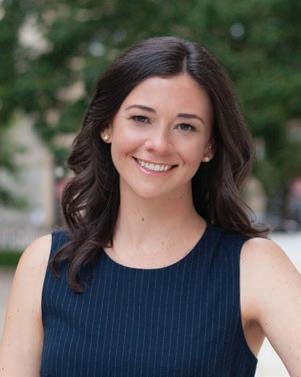
17 minute read
Meet Liz Hutchinson the DBA’s New Young Lawyers Division Chair
from The Docket
by DBA Docket
PROFILE | BY HALEY HEMEN
Liz Hutchinson, The Denver Bar Association’s Young Lawyers Division Chair
While many of us spent the pandemic emptying our Netflix queues, attorney Liz Hutchinson and her husband John experienced the birth of their first child with all the complications and precautions mandated by the pandemic. “Giving birth in the pandemic was both beautiful and isolating,” Hutchinson says. “John and I have been with Caleb every moment of close to the first year of his life. We would never have had this time together as a new family of three in non-pandemic times – we were always on the go. It forced us to slow down and just enjoy the gift of presence.”
Gift as it was, in many ways presence was its own challenge. “To be candid, it has been really hard balancing our careers with full-time parent duties. Because of the pandemic, we did not have child care for Caleb for the first 10 months of his life.”
Hutchinson met her husband when they were both high school teachers volunteering during their faculty day of service. Hutchinson had just returned from backpacking through Australia, New Zealand, and Fiji, and John had spent time doing tropical reforestation work in Australia. They hit it off right away and were married about three years later.
Hutchinson taught social justice at Presentation High School in San Jose, CA, her alma mater. “I think one can only teach about injustice for so long until they are ready to do something about it.” For Hutchinson at age 25, that meant law school. “I always had a legal career in the back of my mind as an option given my interest in politics and addressing inequity, but I was not certain that I was going to study law. However, after teaching social justice for three years, I knew education was not my vocation or role in the justice movement – I wanted to take a more active role. There was no better training on how to meaningfully effect change, in my view, than going to law school. Whether you choose to practice law in the traditional sense or not, law school gives you the tools to work in any industry and with any group of people. You learn how laws are actually written, why and how words matter, and the impact that laws can have, intentional or not. It also teaches you how to think, write, and communicate better than any training I have ever had.”
And Hutchinson really took advantage of her time in law school. “After teaching, it was wonderful to be back in the student’s seat. I soaked it all in – the classes, the student organizations, the externships, and the service opportunities. At the time, I was focused on environmental and natural resources law, so I externed with the US Department of Justice in environmental enforcement and defense, with the EPA in the Office of Enforcement and Compliance Assurance, and with the US Department of the Interior Office of the Solicitor – Rocky Mountain Region. I also spent my 1L summer in Alaska with the Native American Rights Fund focusing on indigenous rights. In addition, I externed for Senior Judge John Kane of the US District Court for the District of Colorado and Judge Elizabeth Weishaupl of the 18th Judicial District, as well as then-State Senator Mike Johnston. I am grateful for each one of those experiences, as they each taught me something very different about the practice of law. I also gained experience in each of the three branches of government, and gleaned insight into how each of them works. I was also president of the Natural Resources and Environmental Law Society and traveled to Navajo Nation as part of DU’s Alternative Spring Break Program.” After graduation, Hutchinson first clerked for now-retired Judge John Webb of the Colorado Court of Appeals, then spent a year with Justice Will Hood of the Colorado Supreme Court, and then a year with Judge Greg Phillips of the US Court of Appeals for the Tenth Circuit. “When I graduated, I had no intention of taking on three clerkships, but you simply don’t turn down the opportunity to serve the Colorado Supreme Court or the Tenth Circuit. Each clerkship offered such tremendous learning opportunities, as well as life-long mentors. Through these clerkships, I learned how to think like a judge and, practically speaking, preserve issues as a trial lawyer for appeal and tee-up motions for future appellate briefs. I also learned the importance of professionalism and collegiality. The Colorado Supreme Court in particular prides itself on being a collegial court. I learned so much from watching how the justices thoughtfully, and respectfully,
disagreed with one another. While we may have intellectual quarrels, lawyers should always rise above and maintain a level of professional decorum and respect for the opposing party. I have not always lived up to this standard, but I do my best to do so every day. Sometimes that means walking away and taking a deep breath before responding or engaging with opposing counsel. Whatever it takes, I try to remember my integrity is always more important than my ego.”
In addition, between clerking and private practice, Hutchinson took a couple years to give back as a Staff Attorney and Pro Bono Coordinator at Equal Justice Wyoming. “I knew I had my whole life to build a career in private practice, so I was not in a rush to make that transition. Accordingly, I wanted to take time to address access-to-justice issues and grow a statewide pro bono program in Wyoming. It deepened my personal commitment to service work, even today in private practice. My philosophy is that, at any given time, every attorney should have at least one active pro bono case. It’s part of our professional responsibility to the rule of law, and to our marginalized community members. Since joining Shook, I have focused my pro bono practice on asylum work for those fleeing gender- and political-based violence. It has been rewarding for me, and impactful for my clients. It’s also a tremendous learning opportunity for young lawyers in private practice – pro bono work may get you into a courtroom faster than any of your corporate clients! Whatever your passion may be, find it and dedicate time to it. It will remind you why you went to law school in the first place, as well as the incredible impact that you can have on your community.”
These experiences, including a service-learning trip to the US/Mexico border helped focus the area to which she would dedicate her pro bono practice: to those fleeing gender- and political-based violence. “My heart will always be with justice work,” says Hutchinson. “But I needed an emotional break from it. What people don’t often talk about is the secondary trauma that attorneys and social workers (and others) face when working with people in trauma and people experiencing poverty. It hit a point where I knew I just couldn’t keep it up. I had private practice in the back of my mind for years because I was drawn to the challenge of sophisticated clients and high-stakes litigation.”
Given her upbringing in Silicon Valley, business litigation at a large, national litigation firm like Shook, Hardy and Bacon was the perfect fit. “I have been able to work on cases ranging from biometric privacy to medical-device product liability, as well as traditional commercial litigation and trade secret cases. It has been wonderfully challenging and engaging. But I’m also with a firm that encourages civic and political involvement, as well as diversity, equity, and inclusion work, so my desire to maintain a solid pro bono practice and stay involved in the local bar has only been met with positive reinforcement, encouragement, and billable credit. Private practice allows you to move through work that touches on all three branches of government, as well as the private sector. It can be wonderfully fulfilling, all things considered.”
Moving into private practice also afforded Hutchinson a bit more flexibility in terms of networking than judicial-bar relationships, which she used to take advantage of the opportunities that the DBA-YLD offered. And, on the recommendation of good friend and then chair-elect of the DBA-YLD, Matt Broderick, she applied to be on the DBA-YLD Executive Council. “I couldn’t turn him down – it was an opportunity for me to give back, to continue my work in the pro bono space, and to rebuild friendships and professional relationships that I had not given enough attention to while spending time in the courts. After even just a few months being in private practice and a part of the Executive Council, I fell in love with the energy of the team and the potential to serve so many young and new-to-practice attorneys in the Denver Metro Area. I wanted to run for chair to see that mission through – particularly after COVID, this is a time to step into leadership and rebuild community. I can’t wait for all that we can accomplish together over the 2021-22 year.”
As chair, Hutchinson sees the year ahead as an opportunity to reinvent bar membership and how members view the DBA-YLD. “I want to create and foster an inclusive community of young and new-to-practice attorneys where we can build professional relationships, bounce ideas off one another, support one another’s professional development, and cultivate friendships. As part of this, our members can expect in person and virtual networking opportunities, small group dinner discussions, CLEs focused on professional development of young lawyers, and opportunities to give back. My call to action for all young lawyers is to step into leadership and to get involved. The DBA-YLD membership is what you make it, and we can’t wait to get to know you.”
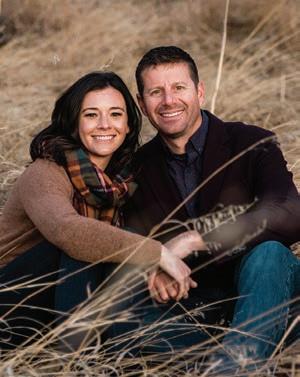
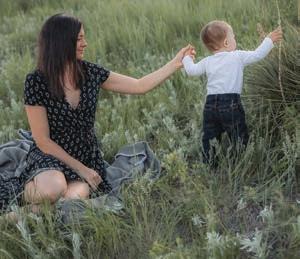
AROUND DENVER
The Denver Cigar Tour
By Randall Peterson
It’s springtime in Denver. Imagine a walk through the neighborhoods of downtown, through the haunts and hollows of her streets and alleyways. There you catch the aroma of something old, inviting, and eternal. The scent halts you in your tracks. The cigar smoke from somewhere nearby triggers something visceral and instinctual, a memory forgotten or one yet to be made. In scent and spirit, they are the memories of our fathers and grandfathers. The smell of history beckons you in to pursue your own pleasures and there, amongst the barons and bricklayers who built the Mile High City, share in the stories of all that is rich and good and timeless. It is the turn of the century. It is today.
Thus, take a walk on your own self-guided Denver cigar tour and taste a different flavor of Denver. Savor its past memories, relish its present glories, and create the future stories yet to be written.
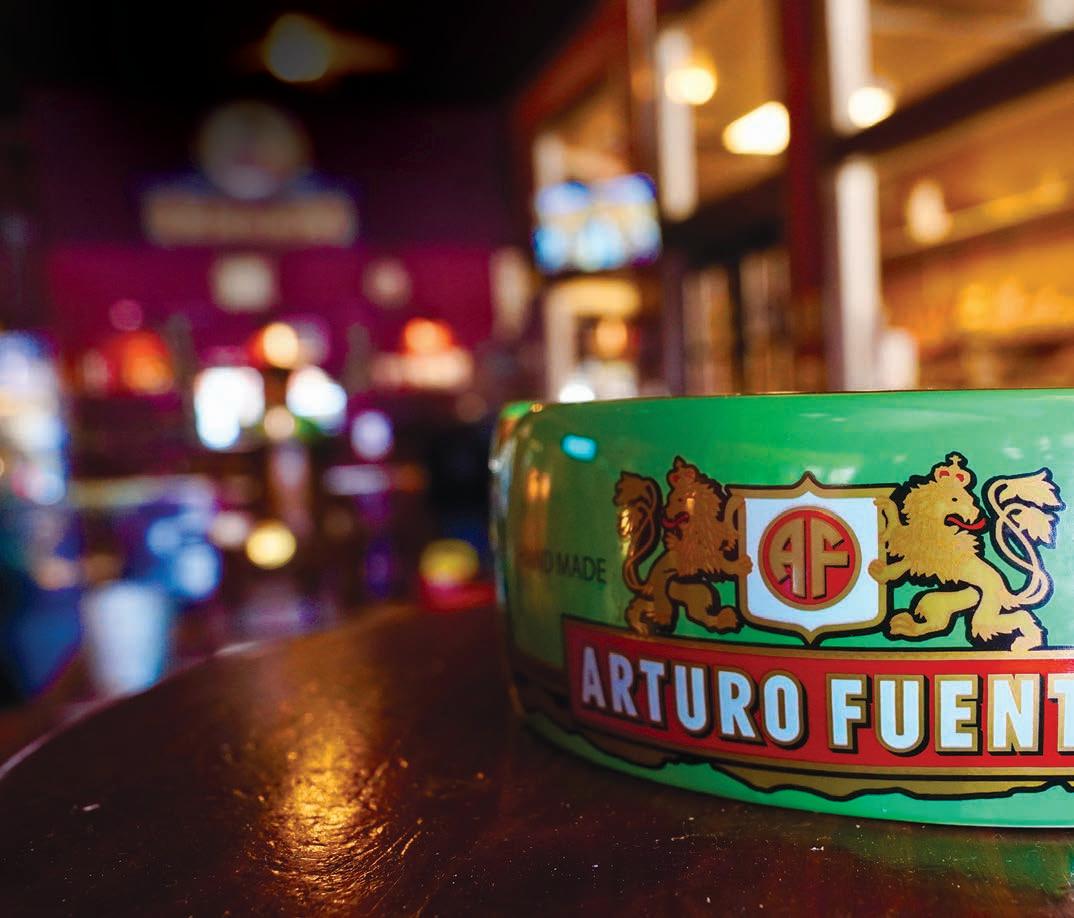
Cigars on 6th — Where Everybody Knows Your Name
Walking into Cigars on 6th you are immediately transported to the world of the quintessential cigar shop. It feels like the perfect neighborhood bar, one that you don’t want to leave.
The ambiance is visually stimulating. Dark red hues, black wood, and handsome cabinetry set the mood and excite the palate. The walls are richly adorned with an engaging mix of cigar art, vintage photos of old cigar rollers, antique tobacco advertisements, and, adding to the neighborhood flair, photos of regular patrons and local celebrities who frequent the shop. A deer head is displayed with a cigar in its mouth — a
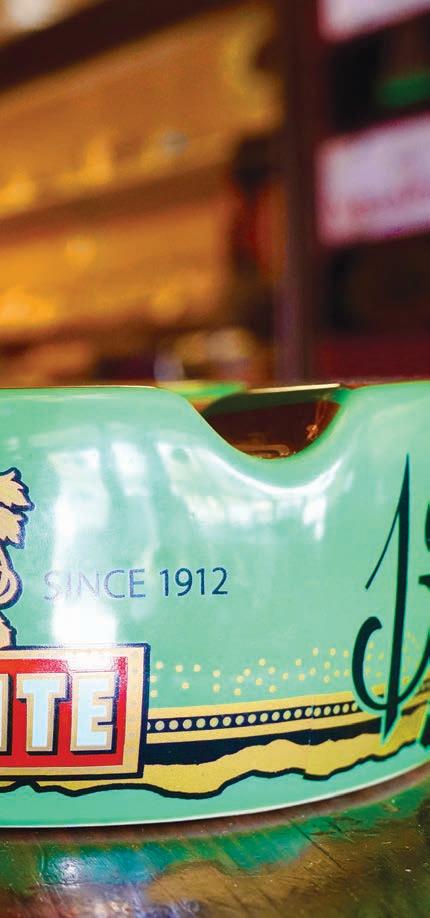
stag with a stogie. Included in the mix is an incredible collection of cigar label art — that’s right, pictures made from varying cigar labels. And they are not just any pictures: Avalanche hockey, The Last Supper, a Spanish bullfight, the Constitutional Convention, and that timeless classic Dogs Playing Poker.
Its two intimate circular seating areas boast a combination of antique leather chairs and wrought-iron seating, invoking a Scottish royal antechamber. Collectively, the environment is both Victorian and masculine at the same time, perfectly suited to enjoy the perfect cigar, of which the patron will have no trouble finding. Cigars on 6th boasts up to 700 different facings (types of cigars) including boutique, specialty, and hard-to-get cigars, so the customer can truly get almost anything they want from the two separate walk-in humidors.
Its selection and service, both exemplary in every way, will have you coming back for years to come. Cigars on 6th makes it easy to be at home in your own neighborhood cigar lounge.
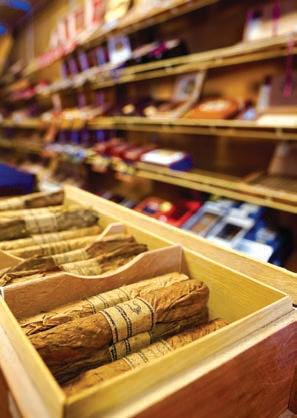
Capitol Cigars — The Oasis in the City
If you are in the Capitol Hill neighborhood or find yourself doing business under the golden dome, the aptly named Capitol Cigars is only a short walk up Colfax but feels miles away from it all. Like an oasis in the desert, this inviting shop provides an ideal getaway when seeking a good smoke and the solitude that comes with it.
Capitol provides a fantastic array of cigar selections in its well-stocked humidor and provides a wonderful space in which to enjoy them. There is an open and spacious seating area where you can browse cigar and tobacco trade magazines. Hardwood floors and high palm leaf ceiling fans give it an old-world feel of Latin American simplicity, authentic and honest.
And like any oasis, there are beverages to imbibe. In the spirit of Colfax’s continual evolution, providing something for everyone, Capitol has added a casual bar for beer and cocktails. This quiet haunt by day awakens at night as a destination for those taking in a show at the Ogden Theater next door or wanting to experience the nightlife on Colfax, cigars allowed. “Smoke em’ if you got em’” rings true at Capitol Cigars.
It’s a perfect spot for a cigar over a long lunch, a sit-down break from exploring Colfax, or a happy hour and cigar after work. Whatever time of day, numerous happy hours can be spent at Capitol Cigars.
Palma Cigars — The Artist’s Studio
Lodo has had its share of cigar bars, especially during the cigar boom of the mid-1990s when Lodo and cigars both collectively rose in prominence. Today, Lodo’s go-to cigar shop is Palma’s Cigars and Bar. The quirky, eccentric atmosphere is akin to a Boulder/California vibe. Its full bar serves an impressive selection of Colorado wines and specializes in the classic cocktail. With multi-colored glass lamps descending from the ceiling at different heights and a minimalist simplicity similar to a 1960s bungalow, this is not your grandfather’s smoke shop.
The red brick dwelling on Larimer is not unlike so many of the studios, bars, and galleries in the area, but the novelty of Palma is that it is a working art studio and its product is cigars.
Clay Carlton is the master torcedor (Spanish for cigar roller), who apprenticed himself to the art in an effort to preserve the timeless magic of hand rolling cigars. Carlton personally crafts all of the cigars for sale at Palma. With seven different tobacco blends produced in all the standard cigar sizes, a custom-made cigar awaits patrons at the Palma. Carleton can be found at the front of the store most days rolling, cutting, stripping, and binding tobacco as it magically evolves from stem to smoke. Patrons can watch
AROUND DENVER | BY RANDALL PETERSON
the artist at work in his studio, educate themselves on the cigar making process, and then taste the fruits of his exquisite labor. While smoking cigars is an art form of its own, the growing and production of cigars is of course even more refined, taking years to transform from seed to shelf. The process is as sublime as the product and at Palma, cigar aficionados can visit the artist in residence.
Grab a Palma cigar on your way to a summer ballgame and walk the storied streets of Lodo. There, you can almost hear the workers of the old warehouse district who eked out a living by the sweat of their brow and the skill of their hands, echoing the adage of Woodrow Wilson’s vice-president Thomas Marshall in saying “What this country needs is a good five-cent cigar.” Many of which were undoubtedly smoked in those long-since defunct, cavernous spaces of another era.
The Churchill Bar at the Brown Palace — Dancing with the Grand Dame of Denver
If classical elegance is your desire, then punch your dance card with the Churchill Bar at the Brown Palace. While the Brown is an icon in Denver, the Churchill Bar is a smoking lounge that provides its own rich experience. It is a special place where cigar aficionados, new and old alike, come to make memories or commemorate traditions. Whether it be your virgin visit or a return as an old friend, to visit the Churchill is to create your own timeless piece of history.
And the setting is ripe for such moments. Wingback leather chairs, rich oak paneling, elegant carpeting, tufted leather chairs and sofas (for group socialization), and forest green and gilded wallpaper make the Churchill Bar the classic cigar club of elegance and sophistication.
Adding to the ambiance is a five-star staff of the highest quality. They quickly learn your name and the flavor of your cocktail, whatever that may be, including specialty and high-end bourbon, scotch, and wines that simply cannot be found elsewhere. They keep a variety of cigars on hand in their humidor, although most come for the spirits and grandeur and bring their own cigars.
Most of the patrons, myself included, have a history here. It is where I called my friends and family, telling them about my first law job with a celebratory smoke of a classic Romeo y Julieta cigar. Like so many others, I relished the glorious anticipation of the not yet seen, reflected on how my life was about to change, and was humbled by the journey that allowed me to take my place and be part of the Churchill. It is a place where people want to belong, a place where every man can be a king. Or, even more apropos, a sultan.
While there are a few framed pictures of the bar’s namesake, the irascible prime minister who saved England from the Nazis then lost his next election, the marquee piece at the Churchill is the painting “The Sultan’s Delight.” It was commissioned for the hotel at its opening in 1892. The grand painting shows a bearded Ottoman, one of wealth and power, sailing through the Bosphorus. He is immediately surrounded by four women while others near the stern float ethereal into the Turkish sky with Istanbul’s mosques and minarets framing the background.
The irony is easily lost among the opulence. The keen student of history may observe that the most dominating feature in the Churchill Bar is the glorification of the Ottoman Empire, responsible for Churchill’s greatest military defeat while he was First Lord of the Admiralty, the 1915 battle of Gallipoli in World War I. In other words, at the Churchill Bar just as in 1915, Churchill remains secondary to the sultans.
Yet, for the classic smoking club, the Churchill Bar is second to none.
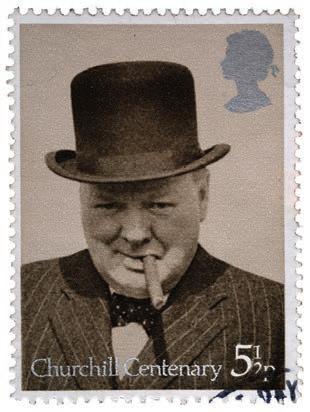
The Denver Cigar Tour
The writer and female cigar smoker George Sand wrote in 1867, “The cigar numbs sorrow and fills the solitary hours with a million gracious images.” As we emerge from the darkest of winters and awaken into a springtime of a new era as COVID subsides, Sand’s words ring especially true. We can smoke for what we have been through — endurance and loss. We can smoke for a better future, for aspiration and accomplishment. In the cigar bars of Denver, there are a thousand stories that rest in the humidors and are told by their carriers in leather chairs, their secrets ascending to the heavens in curls of blue smoke. As Colorado reopens, there are a thousand more tales waiting to be created, adding to the tapestry of all that makes Denver what it is: past memories, present glories, and future stories yet to be written.
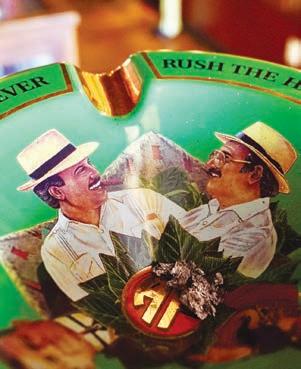
RANDALL PETERSON is an attorney, educator, professor of business law, and Northglenn City Councilman. randallleepeterson@gmail.com










